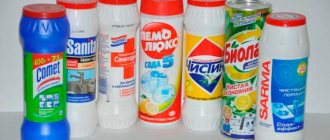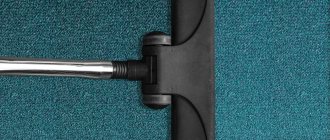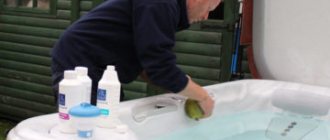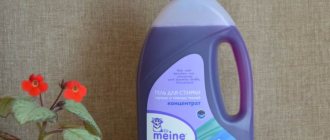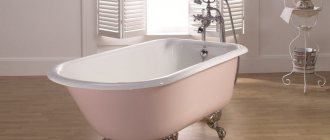A snow-white, shining bathtub invariably reveals a good housewife who pays close attention to all the details of the house. But, before washing an acrylic bathtub, you should carefully study the recommendations of specialists. Indeed, sometimes, active cleaning of this plumbing equipment with inappropriate means causes the appearance of yellowness and grayness.
The bath should be cleaned daily using a small amount of detergent or available products. It should be noted that some homemade recipes (for example, soda or citric acid) are not suitable for cleaning plastic from dirt and limescale.
Photo: bath before and after cleaning
To choose the right recipes, you need to study customer reviews and advice from professionals. To do this, we have collected the most common recommendations together.
Detergent overview
Specialized cleaning products are available for bathtubs with acrylic coating. They help to quickly get rid of rust, plaque and wash the liner after swimming with colored foams.
Good reviews about the spray and gel from RAVAK Cleaner. These are products that are manufactured by a well-known manufacturer of acrylic bathtubs. It contains mild cleaning components that work well on the most common stains. In particular, Ravak will help wash rust from the bottom of the bathtub, remove grease and soap residues from the walls and restore shine and whiteness to acrylic.
Ravak for hot tubs
Bass is another well-known acrylic bathtub cleaner. This product comes in the form of a gel, unlike Ravak, it cleanses not only of dirt, but also of germs. It contains weakly concentrated acids. The product is applied to problem areas of the bath, distributed evenly over them, and then washed off with water. To remove it, you need to wipe the liner with the hard side of the sponge.
Cif acrylic bath cream has a pleasant smell and cleans plastic well of soap residues. But it will not help with pronounced yellowness or rust. It is considered more of a preventative than an active cleanser.
Cif Strength Cream for acrylic bathtub
The most common cleaners include Domestos and Sanox. In general, these funds are suitable, but we will tell you more about each below.
Is it worth washing with chemicals and which one to choose?
Acrylic is a wear-resistant material, but is easily damaged. Caring for the surface of such a bath should be gentle and, preferably, daily. Under no circumstances should acrylic be cleaned with the following substances:
- abrasives;
- chlorine;
- formaldehyde;
- oxalic acid.
Scratches and damage form on the coating and it irreversibly loses its original appearance. What kind of sponges can you use to wash the bowl? This can also be done with a regular sponge, rinsing the surface generously with water. But if the contamination is significant, it will not be possible to do without chemicals.
For more information on how to properly care for an acrylic bathtub and get rid of rust, limescale and yellowness, read our article.
In all the variety of names of cleaning products for the care of acrylic plumbing, it is important to choose those that have a liquid or gel-like consistency. It is optimal to use formulations in the form of a spray. If you don't have any cleaning products on hand, you can use regular shower gel.
What is the best way to clean at home?
Domestos
This modern detergent has rightfully earned popularity among owners of acrylic bathtubs, as it perfectly combines disinfecting properties and the ability to clean all types of dirt, better than many other products, without causing harm to the acrylic-coated bathtub.
- disinfectant effect : helps to cope with most germs;
- forms a thin water- and dirt-repellent layer , which helps to maintain the effect of cleanliness longer;
- low price .
The disadvantages include the following:
- smell , it is best to work with a mask;
- hydrochloric acid (you cannot keep the product on the surface for a long time).
- People with sensitive skin may experience an allergic reaction upon contact with the coating treated with Domestos; it must be rinsed very carefully.
Sanox
Perfect for cleaning acrylic bathtubs, as in addition to cleaning and disinfecting, it whitens the surface. The manufacturer offers Sanox in three versions: gel, foam and spray.
Pros:
- ease of application;
- efficiency and gentle cleaning of acrylic coating;
- affordable price .
- Individual intolerance can cause allergies ;
- Strong smell .
The product in the form of a spray should be applied to the surface from a distance of 10 cm; this is a very convenient option for evenly distributing the composition, as well as applying it to hard-to-reach places.
Sanfor
Among the Sanfor brand products there is a special cleaning composition for acrylic surfaces “Acrilight”. Advantages:
- moderately thick consistency that does not allow the composition to spread;
- there is no pungent odor , like most products;
- effectively removes plaque and dirt;
- there is no dispenser .
Adrilan
A cleaning composition in the form of a spray, which is positioned as a special product for acrylic surfaces, including shower stalls.
Advantages:
- Ease of application;
- Economical;
- has a very pungent odor , so be sure to leave the bathroom door open while using it;
- may cause allergies , irritation of the skin and mucous membranes.
Cif
It is optimal for cleaning an acrylic bathtub, as it has the following characteristics:
- does not contain abrasive elements ;
- Has a gel-like form ;
- ease of application and speed of action;
- low cost.
The downside could be:
- individual intolerance , therefore, when working with the composition, it is necessary to use gloves and protect the respiratory tract.
Tim pro
This product has won the recognition of housewives, as it perfectly helps to clean the bowl from yellow deposits. Advantages:
Folk remedies for cleaning
Unlike enamel, acrylic perfectly withstands the effects of acids. Therefore, the easiest way to clean a bathtub is to buy a solution of citric acid and dilute it with water. The ratio should be minimally concentrated. For example, for 50 liters of water take 1500 ml of 7% acid. It is important to note that only citric acid solution is allowed to be used (powder will not work).
Another option for whitening an acrylic bathtub is to wipe it with pure lemon juice. Of course, this method is not cheap, but its effectiveness has already been tested by many housewives. A fresh lemon is cut in half, after which the gray areas are rubbed with the juicy side. The juice must be left on the plastic for at least 8 hours. Afterwards, simply rinse with water. This is the only safest way to rinse a bathtub before bathing a child.
Vinegar works great for removing limescale and yellowing. It is best to use either acetic acid or a 9% apple solution. The proportions are similar to citric acid - for a full bath you need to take 1500 ml of acid and dissolve it in water. The liquid must be left for 10 hours, then rinsed off, wiped the walls with a fleecy cloth and spilled with water again.
Even regular bleach can help restore the shine to your bathroom. It is important to remember that it is strictly forbidden to use products that contain chlorine. Therefore, it is better to take a product for colored fabrics or wool. The stain remover is evenly distributed over the bottom and walls of the bathtub, and then left for several hours. The minimum is 4 hours, the maximum is 8, but more is not recommended. After time has passed, the bath is washed with plenty of water and wiped with a sponge.
The most difficult thing to clean at home is an acrylic whirlpool bathtub. The main problem that its owners face is that the injectors become contaminated with soap deposits and salt deposits. To get rid of this, you need to pour a weak chlorine solution into the hydromassage system. In order to completely clean the system, 20 liters will be enough. The liquid must go through several cycles through all nozzles, after which it must be drained.
What should not be used to clean a dirty acrylic bathtub:
- Acetone. This is strictly prohibited, as it corrodes the plastic. The consequences of such cleaning can be not just stains without paint, but real holes in the liner;
- Petrol. Just like acetone, this substance has a very negative effect on acrylic and the paints with which it is coated. After such washing, unsightly gray spots and stains remain;
- Soda and other powders. By itself, baking soda is an excellent bleach, but it is too abrasive. Due to active washing with powders, scratches appear on the glossy surface of acrylic, which after a while can become cracks.
In addition to the choice of product, the method by which the bath is cleaned plays an important role.
How not to wash an acrylic bathtub:
- Never use hard brushes made of artificial bristles or metal brushes. They scratch acrylic mercilessly, causing small scratches to form on its surface. It is best to use a special sponge. It differs from a regular laundry sponge in pore size and material;
- Do not mix multiple detergents during washing and rinsing. Some of them contain dangerous components that, when reacting with substances from other products, form a poisonous gas. In particular, Domestos is known for this effect, which, when mixed with other cleaning gels, produces chlorine gas;
- Do not wash off chemical cleaning products with hot water. Also due to the likelihood of the formation of toxic fumes.
Cleaning the bathtub is carried out only with gloves
What is the acrylic surface afraid of?
Powders, creams and pastes, which we are used to using to tidy up cast iron and steel bathtubs, should not be used at all. The fact is that many of their components, which are safe for enamel, are considered too aggressive for acrylic.
At best, they will erase the shiny coating and leave scratches; at worst, they will completely destroy the structure of the material.
Acrylic bathtubs do not belong to the group of expensive products; more often they are products of the middle segment (except for elite models). For example, the BAS Fantasy model with hydromassage costs about 30 thousand rubles. – a budget option for a family with average income
For example, all-purpose cleaning powders and pastes often contain fine abrasives. The smallest solid particles do not leave marks on the enamel coating, but can ruin acrylic, which is sensitive to mechanical damage. Therefore, such universal products for the kitchen and bathroom as “Komet”, “Domestos”, “Silit” (powder) are prohibited.
In addition to abrasives, cleaning products should not contain the following ingredients:
- chlorine;
- formaldehyde;
- acetone;
- ammonia;
- oxalic acid.
Chlorine corrodes the material, making it porous and unsightly. Acetone, ammonia and some solvents destroy the shine of the coating, gradually destroying the top layer. Acids and formaldehydes are also incompatible with acrylic.
Relatively soft acrylic is afraid of hard and sharp objects. Please note that even such a sanitary measure as washing pets is dangerous for him, as their sharp claws can easily damage the coating. For such hygiene procedures, it is recommended to use a plastic basin or a specially installed tray with a separate shower.
If the damage to the bathtub turns out to be catastrophic, it can only be saved by restoration with liquid acrylic, which is carried out using special technology by professional plumbers
If you hand wash or clean bulky items in the bathtub, use a rubber mat. It will protect the bottom and walls of the container from damage that can be caused by metal buttons, fasteners or zippers. The same rug is an excellent stand for a plastic basin, which can also scratch acrylic.
Another threat to acrylic bathtubs is very hot water. It does not affect as clearly as sharp objects, but over time it destroys the top layer, making it more porous and weaker. As a result, all the negative contents of tap water - lime, rust, dirt - are absorbed into the acrylic and make the surface of the bathroom unattractive.
To ensure that the water contains fewer foreign impurities that negatively affect acrylic, fine filters are installed on the supply pipes. In the event of a water supply accident, they trap particles of clay, sand, and contaminants.
Now let's look at effective products for acrylic bathtubs, which are ideal for adding shine, removing scratches and regular maintenance.
How to clean an acrylic bathtub from yellowness
Yellowness is the most common problem faced by owners of acrylic bathtubs. The surface of the plastic turns yellow for several reasons:
- Incorrect care. In particular, the use of inappropriate means for cleaning the walls, treatment with powdery products;
- Bath age. Naturally, over time, the white color of the bath becomes more beige or yellow. This can only be combated by bleaching the liner;
- High water hardness. Chlorinated or saturated with other salts liquid has a negative effect on plastic. To solve this problem, you need to add a small amount of special water softening agents to the water.
Age-related yellowing of the bathtub
To get rid of yellowness, you need to choose a suitable cleaning agent and distribute it evenly over the entire surface of the container. If the bathtub is not darkened over the entire surface, but there are individual yellow spots, then under no circumstances use abrasive products on them. It is better to apply the bleach in several layers.
How to whiten a bathtub:
- Lemon, lemon juice, citric acid. This is a natural bleach that effectively copes with the natural causes of yellowing: dirt, plaque or soap residue;
- Vinegar and its derivatives. Pure vinegar cannot be used, but its solutions are not only possible, but also necessary. It will not only whiten the surface of the plastic, but will also destroy the majority of pathogenic microorganisms;
- Professional bleaches for acrylic. These are Sanox, Cersanite, SanElite;
- Dishwashing detergents also work well to bleach. In particular, good reviews about Fairy.
Possibility of using Domestos
Its use is justified by eliminating contaminants that have penetrated into the deep layers of the acrylic coating. This product removes not only plaque, but also unpleasant odors.
Advantages and versatility of the product
Domestos contains hydrochloric acid, so it effectively copes with even the most difficult stains. It can be used to clean most surfaces in the bathroom.
The advantages of Domestos include:
- safety;
- destruction of pathogenic bacteria;
- suppression of foci of fungus;
- surface whitening;
- low price.
When used correctly, the product does not damage the acrylic coating. If necessary, use it 2-3 times a month to keep the bath clean.
Indications for use
Domestos is recommended to be used to eliminate:
- unpleasant odor;
- old rust stains;
- limescale;
- fungal colonies, etc.
"Domestos" is intended for cleaning, bleaching and disinfecting the surface of the bathtub.
In addition, it can be used to eliminate yellow stains caused by high chlorine content in water.
Precautionary measures
When using Domestos, you need to take some precautions:
- Before cleaning, put on gloves and clothing that you won’t mind throwing away if the acid contained in this product gets on the fabric and discolors it.
- Use a respirator to protect your respiratory system from toxic fumes.
- Avoid prolonged contact of Domestos with acrylic.
The cleaning agent is applied to the sponge and distributed throughout the bath. It is left for 3-5 minutes. Then wipe the coating with a soft cloth and rinse thoroughly with cold water.
After cleaning the bathtub, it must be treated with wax polish.
Domestos should not be mixed with other cleaning products: this will lead to dangerous chemical reactions and the release of toxic fumes.
Is it possible to wash an acrylic bathtub with Domestos?
Considering that this is one of the most common and advertised cleaning products in the CIS, this question torments more than one housewife. In general, yes.
Domestos Ultra White for baths and toilets
But, there are a number of rules on how to wash an acrylic bathtub with Domestos and not spoil it:
- Domestos should not be left for long periods of time. It contains such strong acids that they can easily corrode even vitreous enamel, not to mention the dyes that are used for plastic. The maximum exposure time of the product is 10 minutes;
- How to use it: you need to apply a cleaning agent to the upper part of the wall and spread it with a sponge over the entire wall. All work must be done with gloves, otherwise allergies may develop. Afterwards, you need to leave Domestos on the acrylic for up to 10 minutes, wipe with a sponge again and rinse off;
- To consolidate the effect and give the bath shine, it is also treated with a wax-based polish. This is completely harmless; after such cleaning, you and your children can bathe.
Recommendations for cleaning depending on the type of contamination: useful recipes
When choosing a cleaning product, take into account the characteristics of the contamination. Certain folk recipes are especially effective for removing old stains.
Limescale
To eliminate it, it is better to use vinegar. First, warm water is drawn into the bath. After this, add 1 liter of vinegar to the liquid. The solution is left for 12 hours. After this, it is drained, the surface is rinsed and thoroughly rubbed with a soft cloth.
It is not recommended to leave the solution in the bathroom for a long time, because... this will lead to an undesirable reaction.
If the plaque is old, it is better to use a product that includes citric acid, vinegar, salt and soda. First, water is taken into the bath and vinegar is poured. Then 50 g of all bulk components are dissolved in the liquid. After 10 hours, the mixture is drained and the surface is thoroughly rinsed. This product not only removes limescale, but also has a whitening effect.
Yellowness
A high content of chlorine and iron impurities leads to yellowing of the surface. To eliminate the defect, use mustard powder with soda. The components are taken in equal proportions and diluted with water to the consistency of thick sour cream. Apply the product to contaminated areas and leave for 30 minutes. Then the mixture is washed off and the surface is dried with a dry towel.
Mustard powder with soda effectively removes yellow deposits from acrylic bathtubs.
Rust
To eliminate it, folk remedies are effective, including hydrogen peroxide, ammonia and lemon juice. The last component has the mildest effect. Small rust stains can be removed with the juice of 1 lemon. They treat contaminated areas and leave the composition for 10 minutes. After this, the surface is wiped with a sponge and rinsed with water. To enhance the effect, dissolve 1 tbsp in juice. soda
The resulting composition is used to treat contaminated areas.
Silicone sealant
Over time, it darkens and becomes moldy. In this case, it needs to be replaced. To remove old sealant, vinegar essence and white spirit are used. Soak a soft cloth with the chosen product and wipe the surface with it. After 7 minutes, it is rinsed with water and treated again with a solvent. The procedure is repeated until the old sealant is completely removed.
Glue
Remains of glue from an acrylic bath can be removed with a solution of citric acid. To prepare the product, mix 30 g of dry powder with 1 liter of water. Then the fabric is soaked and placed on the contaminated area. After 15 minutes, the surface is washed. The softened glue is removed. Then a cloth soaked in a solution of citric acid is applied again. The procedure is repeated until the coating is cleaned.
Primer
To eliminate it, do not use formulations containing alcohol and other aggressive substances. Such contamination can only be removed mechanically. First, the primer is softened with warm water, after which it is carefully scraped off with a blade.
Is it possible to wash an acrylic bathtub with Sanox?
A more affordable analogue of Domestos is Sanox. It has similar properties, but in addition to disinfecting and cleaning, it also quickly whitens the surface of an acrylic bathtub. The rules for its use are similar to Domestos.
Stork SANOX Gel
The product is evenly distributed over the walls and bottom of the plastic liner, after which it is not washed off for some time. There are several types of Sanox for baths:
- Gel;
- Foam;
- Spray.
The gel and foam are applied with a regular sponge to the entire surface or individual areas of the bath, and the spray is sprayed onto the acrylic at a distance of 10 cm. This will cover the maximum area and avoid increased concentration of the product at one point.
Rules for proper use
The bath does not require serious care, but it is still necessary to follow the rules.
- Periodically bringing the plumbing to a decent condition in 5 minutes - after water procedures, rinse with clean water . Acrylic does not absorb dirt, so this type of washing is sufficient.
- After use, wipe the bathtub with a sponge and soapy water . Next, dry to avoid streaks.
- restoration kits for removing scratches - they are sold in hardware stores.
How to remove scratches
Along with all sorts of defects on the surface of the bathtub in the form of dirt (yellowishness and plaque), scratches may appear - the result of careless handling of plumbing. The material - acrylic - is quite unique, since it is easily susceptible to damage, but it can be easily removed from the surface.
If the scratch on the bathtub is minor - less than a millimeter - then polishing with felt material is perfect. A guide to removing scratches can be viewed in the photo with step-by-step actions.
For deep damage, liquid acrylic is used. You need to buy a special kit for repair work; its cost is insignificant, but you can find a tube of the substance and a spatula for application. Acrylic is applied to the damaged area and dries. After this, you should polish the sealed area on the bathtub.
Substances that destroy acrylic
- Powders and cleaning products that contain abrasive particles. This also applies to dry soda. They provoke the appearance of micro-scratches, which make the surface matte and susceptible to contamination.
- Chlorine-containing products. They destroy the top protective layer, as a result of which acrylic plumbing becomes dull and loses its characteristic glossy shine. In bathtubs with a hydromassage function, bleach can damage rubber and plastic parts.
- Acetone and similar solvents. They render the structure of the polymer that acrylic consists of unusable. If the contact is prolonged, the bath becomes deformed.
- Ammonia, formaldehyde. They give a similar effect as solvents.
- Concentrated alcohols, alkalis and acids, as well as products containing them. Exposure to these caustic chemicals gradually destroys the acrylic, leading to the formation of small cracks.
- Metal brushes and scrapers, hard sponges and rags are taboo for such plumbing equipment.
- Boiling water. High temperatures can cause the bathtub to deform, so use water no higher than 70 degrees.
What not to use when cleaning
If you have an acrylic bathtub at home, then you need to know what cleaning product you should not use. The properties of acrylic determine which cleaning agents and cleaning devices can be used when washing an acrylic bathtub.
Acrylic is a liquid metal that becomes solid when interacting with certain chemicals. Acrylic bathtubs require special care, since an incorrectly selected cleaning agent or detergent can cause damage to the structure of the coating.
Before you start cleaning your bathtub, be sure to check the composition of the cleaning product you choose and make sure that it does not contain the following components:
- Formaldehyde
- Chlorine
- Acetone
- Alkali, acids, ammonia
Please note: the chosen product should also not contain even small abrasive particles that can ruin the appearance of the bathtub coating.
What is good about acrylic: advantages
Acrylic bathtubs
Often owners of acrylic bathtubs are interested in how to clean them properly, because such plumbing fixtures are capricious and do not tolerate careless handling. In fact, caring for acrylic is very easy, unlike other materials.
The ease of cleaning can be explained by several properties of the polymer:
- Little porosity . Acrylic has extremely small pores, if any, and therefore dirt is not absorbed, but remains on the surface. So, you can simply clean your plumbing fixtures every day with a cloth and soap and it will never lose its appearance.
- Smoothness . Due to the fact that acrylic is smooth, harmful organisms cannot penetrate the material. So no abrasives are required to clean the surface.
- By the way, manufacturers often talk about the self-cleaning effect . This does not mean that the surface cleans itself. Simply due to the smoothness, dirt is repelled. So you have to clean it less often. Most often, cleaning can be done with plain water and soap.
Disinfection
The process under consideration involves killing pathogenic bacteria and creating an ideal cleanliness of the bath for hygiene procedures. Before doing this, you should make sure that there is no yellowness, rust stains or plaque on the surface. After this, disinfection is carried out with specially designed cleaners.
Special disinfecting compounds are simply necessary for treating acrylic baths, since the state of health largely depends on this and reduces the risk of dangerous infections. You can watch the video or step-by-step photos to see how to carry out disinfection.
Features of cleaning whirlpool baths
The hydromassage bath is equipped with special sprayers that are connected to a circulation pump. It is this that creates the pressure of water, which under strong pressure comes out through the nozzles in a given direction. Moisture should not accumulate in the nozzles, as this leads to mold growth and the proliferation of microorganisms. The cleaning process for such a bathtub is as follows:
- The bowl is filled with hot water, the level is 5-7 cm above the nozzles.
- Water circulation is turned on.
- 50 ml of liquid is poured into the bath, which is used to clean dishwashers.
- The hydromassage mode is switched on for 15 minutes.
- All that remains is to drain the water and start the hydromassage mode with clean water. This will help flush the injectors.
Why acrylic needs to be cleaned carefully
Wear-resistant acrylic, used in bathroom fittings, is a type of durable and impact-resistant plastic. However, the material can easily be damaged if not properly maintained.
To clean the surface from dirt and all kinds of deposits, do not use hard metal sponges or abrasive powders. The main danger for acrylic is contact with sharp objects, which can damage the integrity of the coating and leave deep scratches. So, below you can find out how to wash an acrylic bathtub and how often you can do it so that the surface is clean and at the same time not damaged.
Important : Do not bathe pets or wash, for example, kitchen utensils in a bathtub made of acrylic fiber. If there is such a need, it would be good to lay a thick rubber mat on the bottom.

